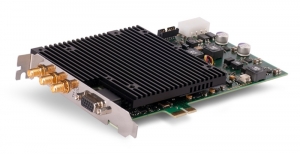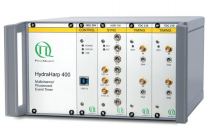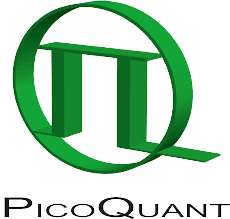The MultiHarp 160 is designed as a plug-and-play event timer and Time-Correlated Single Photon Counting (TCSPC) unit which is optimized for applications that require a large number of fast and precise timing channels. The high quality and reliability of the MultiHarp 160 is reflected by our unique 5-year limited warranty.
Scalable up to 64 input channels
The number of input channels can be scaled to your needs: the main unit (MultiHarp 160 M) provides 16 of them and can be expanded with up to three extension units (MultiHarp 160 X). Each extension unit adds 16 channels to the event timer, thus providing a choice of 16, 32, 48 or 64 synchronized input channels. The MultiHarp 160 M also features a synchronization channel as a timing reference for all 16 to 64 input channels. This synchronization channel supports sync rates of up to 1.2 GHz for periodic sync rates. The data from all input channels are combined into a single data stream that is accessible via the USB 3.0 interface. No additional synchronization tools are required.
All channels of the MultiHarp 160 – including the common sync input – can be used as detector inputs, e.g., for coincidence correlation or coincidence counting. The MultiHarp 160 is also perfectly suited for performing TCSPC with multiple detectors using forward start-stop operation. Here the common sync channel allows for synchronization with the excitation source.
Fast and precise event timing
The MultiHarp 160’s smartly designed time-to-digital converters (5 ps base resolution, <650 ps dead time) allow to fully exploit the count rate limits of time-correlated single photon counting, without having to compromise on the time resolution for many modern single photon detectors. With its ultrashort dead time, multiple photons per excitation cycle can be detected even at the highest repetition rates achievable by modern picosecond pulsed lasers (requires a detector from the PMA Hybrid Series).
Each input channel also features easily accessible parameter settings, which include the trigger parameters as well as programmable timing offsets and hold-off times.
Data interface for external FPGA boards
For applications with high count rates at multiple input channels, the data read-out speed and/or the data processing speed by the computer is the major bottleneck. This bottleneck can be bypassed by reducing the data size that is sent to the computer. Such a data reduction is for example done in the histogramming mode of the MultiHarp 160, where TCSPC histograms sent to the computer are calculated out of the arrival times of the input signals by the hardware itself.
To enable the greatest possible flexibility, the time tagging data stream of the MultiHarp 160 can be accessed by external FPGA boards via a dedicated FPGA interface. This way, the method of data preprocessing can be tailored to the specific application.
Detailed information on the external FPGA interface including programming examples can be found here.

White Rabbit ready event timer
White Rabbit is a fully deterministic, Ethernet-based timing network which provides sub-nanosecond accuracy and precise synchronization of devices over large distances. Thanks to its White Rabbit interface, the MultiHarp 160 is ready to be integrated into set-ups that are using this emerging technology.
| Input Channels and Sync |
Constant level trigger on all inputs, software adjustable |
| Number of detector channels (in addition to Sync input) |
16 (Main unit)
32 (Main unit + first extension unit)
48 (Main unit + first and second extension unit)
64 (Main unit + first, second, and third extension unit) |
| Input voltage operating range (pulse peak into 50 Ohms) |
-1200 mV to 1200 mV |
| Input voltage max. range (damage level) |
±2500 mV |
| Trigger edge |
falling or rising edge, software adjustable |
| Input pulse width |
> 0.4 ns (rise/fall time max. 20 ns) |
| Time to Digital Converters |
| Minimum time bin width |
5 ps |
| Timing precision* |
< 45 ps rms |
| Timing precision / √2* |
< 32 ps rms |
| Dead time |
< 650 ps (can be increased via software up to 160 ns in steps of 1 ns) |
| Adjustable programmable time offset for each input channel |
±100 ns, resolution 5 ps |
| Differential non-linearity |
< 10 % peak, < 1 % rms (over full measurement range) |
| Maximum sync rate (periodic pulse train) |
1.2 GHz |
| Histogrammer |
| Count depth |
32 bit (4 294 967 295 counts) |
| Full scale time range |
328 ns to 2.74 s (depending on chosen resolution: 5, 10, 20, …, 41 943 040 ps) |
| Maximum number of time bins |
65 536 |
| Peak count rate per input channel |
1.5 × 109 counts/sec for 2048 events |
| Total sustained count rate, sum over all input channels |
MultiHarp 160 M:
332 × 106 counts/sec (166 × 106 counts/sec per row of 8 input channels)
MultiHarp 160 X1, X2, X3:
332 × 106 counts/sec (166 × 106 counts/sec per row of 8 input channels) |
| TTTR Engine |
| T2 mode resolution |
5 ps |
| T3 mode resolution |
5, 10, 20, …, 41 943 040 ps |
| FiFo buffer depth (records) |
268 435 456 events |
| Peak count rate per input channel |
1.5 × 109 counts/sec for 2048 events |
| Total sustained count rate, sum over all input channels** |
80 × 106 counts/sec via USB 3.0 interface |
| FPGA Data Interface |
| Throughput T2/T3 Mode |
200 × 106 counts/sec |
| Throughput T2 Direct Mode |
200 × 106 counts/sec per row of 8 input channels
+ 78 × 106 counts/sec for SYNC input |
| Latency T2 Mode |
4.5 µs to 5.0 µs |
| Latency T3 Mode |
4.5 µs to 5.5 µs |
| Latency T2 Direct Mode |
SYNC: 1.7 µs to 1.8 µs
Others: 0.8 µs to 1.2 µs |
| Trigger Output |
| Period |
programmable, 0.1 µs to 1.678 s (0.596 Hz to 10 MHz) |
| Pulse width |
10 ns typ. |
| Baseline level |
0 V typ. |
| Active level (pulse peak) |
-0.7 V typ. (50 Ohm) |
| External Marker Inputs |
| Number |
4 |
| Input type |
LVTTL, < 50 ns rise/fall time, > 50 ns at HIGH or LOW (max 5V for 1 µs), software adjustable hold-off |
| External Synchronization |
| Ref IN |
10 MHz
200 … 1500 mV p.p.
50 Ohm; AC coupled |
| Ref OUT |
Default: 10 MHz
White Rabbit mode: 31.25 MHz
1400 mV p.p.
50 Ohm; AC coupled |
| PPS IN |
1 s, LVTTL |
| White Rabbit interface |
connector for SFP module |
| Operation |
| PC interface |
USB 3.0 |
| PC requirements |
Dual Core CPU or better, min. 2 GHz CPU clock, min. 4 GB memory |
| Operating system |
Windows 8/10 |
| Power consumption |
Max. 150 W |
| Dimensions |
| MultiHarp 160 M (main unit) |
incl. feet and handles 285 × 425 × 100 mm |
| MultiHarp 160 X (extension unit) |
incl. feet and handles 285 × 425 × 62 mm |
* In order to determine the timing precision it is necessary to repeatedly measure a time difference and to calculate the standard deviation (rms error) of these measurements. This is done by splitting an electrical signal from a pulse generator and feeding the two signals each to a separate input channel. The differences of the measured pulse arrival times are calculated along with the corresponding standard deviation. This latter value is the rms jitter which we use to specify the timing precision. However, calculating such a time difference requires two time measurements. Therefore, following from error propagation laws, the single channel rms error is obtained by dividing the previously calculated standard deviation by √(2). We also specify this single channel rms error here for comparison with other products.
**Sustained throughput depends on configuration and performance of host PC.





































